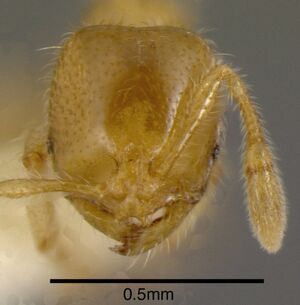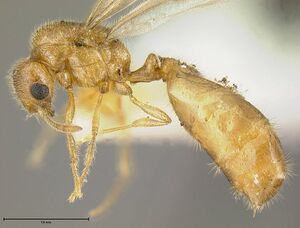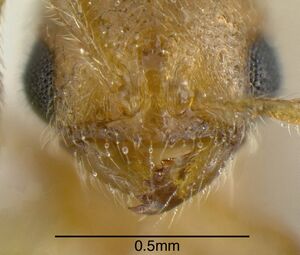Solenopsis striata
| Solenopsis striata | |
|---|---|

| |
| Scientific classification | |
| Kingdom: | Animalia |
| Phylum: | Arthropoda |
| Class: | Insecta |
| Order: | Hymenoptera |
| Family: | Formicidae |
| Subfamily: | Myrmicinae |
| Tribe: | Solenopsidini |
| Genus: | Solenopsis |
| Species complex: | molesta |
| Species: | S. striata |
| Binomial name | |
| Solenopsis striata Pacheco & Mackay, 2013 | |
Workers of S. striata were collected in Berlese extraction litter samples from adjacent to a sphagnum bog, lowland forest, mixed oak, ridge forest, montane hardwood, montane transitional and wet montane cloud forests in Panama and Costa Rica at 600-1175 m.
Identification
A New World thief ant that is a member of the molesta species complex. (Key to New World Solenopsis Species Complexes)
Pacheco and Mackay (2013) – Worker - The worker is golden yellow. The funicular segments are 0.120 mm in total length. The eye is small with 3-5 ommatidia. The mesopleuron and metapleuron are completely horizontally striated. The petiolar peduncle has a small tooth ventrally.
The horizontally striated mesopleuron will separate S. striata from most others in the Solenopsis molesta species complex, including Solenopsis laeviceps (Belize to Brazil), in which the mesopleuron is nearly completely smooth and shiny. Solenopsis striata is also similar to Solenopsis joergenseni (Argentina, Paraguay and Brazil) but can be separated as S. striata has a smaller eye composed of 3-5 ommatidia, compared to 8-10 ommatidia for S. joergenseni.
Keys including this Species
Distribution
Latitudinal Distribution Pattern
Latitudinal Range: 18.568259° to 10.33333°.
| North Temperate |
North Subtropical |
Tropical | South Subtropical |
South Temperate |
- Source: AntMaps
Distribution based on Regional Taxon Lists
Neotropical Region: Costa Rica (type locality), Guatemala, Mexico, Panama.
Distribution based on AntMaps
Distribution based on AntWeb specimens
Check data from AntWeb
Countries Occupied
| Number of countries occupied by this species based on AntWiki Regional Taxon Lists. In general, fewer countries occupied indicates a narrower range, while more countries indicates a more widespread species. |

|
Estimated Abundance
| Relative abundance based on number of AntMaps records per species (this species within the purple bar). Fewer records (to the left) indicates a less abundant/encountered species while more records (to the right) indicates more abundant/encountered species. |

|
Biology
Castes
Images from AntWeb
 
| |
| Worker. Specimen code casent0636200. Photographer J. Longino, uploaded by University of Utah. | Owned by JTLC. |
  
| |
| Queen (alate/dealate). Specimen code jtlc000007603. Photographer J. Longino, uploaded by University of Utah. | Owned by JTLC. |
Known only from the worker caste.
Nomenclature
The following information is derived from Barry Bolton's Online Catalogue of the Ants of the World.
- striata. Solenopsis striata Pacheco & Mackay, 2013: 301, figs. 278, 279 (w.) COSTA RICA, PANAMA.
- Type-material: holotype worker, 61 paratype workers.
- Type-locality: holotype Costa Rica: Guanacaste, Pitilla Field Station, 600-1175 m., 2.v.1996, and 14.ii.1998, nos 17679, 17692, 17694, 17715, 17722, 17741 (R. Anderson); paratypes with same data.
- [Note: Pacheco & Mackay do not specify the holotype date or collection number.]
- Type-depositories: MCZC (holotype); AMNH, CASC, INBC, LACM, MCZC, MPEG, MZSP, USNM, WEMC (paratypes).
- Distribution: Costa Rica, Panama.
Unless otherwise noted the text for the remainder of this section is reported from the publication that includes the original description.
Description
Worker
Measurements (n=5). TL 1.44-1.62 (1.51); HL 0.420-0.426 (0.421); HW 0.360-0.390 (0.369); EL 0.030-0.036 (0.035); ED 0.030; SL 0.288-0.324 (0.313); FSL 0.120-0.132 (0.126); CI 84.5-92.9 (87.8); SI 68.6-77.1 (74.4); PL 0.078-0.084 (0.082); PW 0.090-0.126 (0.113); PI 66.7-86.7 (73.3); PPL 0.102-0.108 (0.106); PPW 0.120-0.144 (0.131); PPI 70.8-90.0 (81.3); WL 0.324-0.342 (0.330); PSL 0.030; PSW 0.030.
Small; concolorous golden yellow; head subquadrate, slightly longer than broad, sides of head convex, posterior border straight; lateral clypeal teeth well developed, extralateral teeth developed as only slightly swollen areas; scape nearly reaching posterior lateral corner of head; eyes small, 3-5 ommatidia; notopropodeal suture deeply depressed; punctures on head small, only slightly larger in diameter than hairs arising from them, all surfaces smooth and glossy, except for mesopleuron and metapleuron, which are latitudinally striated (at least lower half); petiole wider than postpetiole viewed laterally; petiolar node rounded, peduncle with small tooth ventrally; postpetiolar node oval, lacking tooth or flange ventrally.
Abundantly hairy with yellow pilosity; erect and suberect hairs abundant on most surfaces, including scapes and tibiae; longest hairs on mesosoma 0.012 mm; hairs on petiole, postpetiole and gaster curve posteriorly.
Type Material
Holotype worker (Museum of Comparative Zoology) and 61 paratype workers (American Museum of Natural History, California Academy of Sciences, William and Emma Mackay Collection, Instituto Nacional de Biodiversidad, Los Angeles County Museum of Natural History, MCZC, Museu Paraense Emilio Goeldi, Museu de Zoologia da Universidade de Sao Paulo, National Museum of Natural History), Costa Rica, Guanacaste, Pitilla Field Station, 600 - 1175m, 2-v-1996, 14-ii-1998, R. Anderson #' s 17679, 17691, 17692, 17694, 17715, 17721, 17722, 17741.
Etymology
From Latin, stria for furrow, referring to the sculpture on the lower mesopleuron and metapleuron.
References
References based on Global Ant Biodiversity Informatics
- Castano-Meneses, G., M. Vasquez-Bolanos, J. L. Navarrete-Heredia, G. A. Quiroz-Rocha, and I. Alcala-Martinez. 2015. Avances de Formicidae de Mexico. Universidad Nacional Autonoma de Mexico.
- Dattilo W. et al. 2019. MEXICO ANTS: incidence and abundance along the Nearctic-Neotropical interface. Ecology https://doi.org/10.1002/ecy.2944
- Longino J. et al. ADMAC project. Accessed on March 24th 2017 at https://sites.google.com/site/admacsite/
- Pacheco J. A., and W. P. Mackay. 2013. The systematics and biology of the New World thief ants of the genus Solenopsis (Hymenoptera: Formicidae). Lewiston, New York: Edwin Mellen Press, 501 pp.
